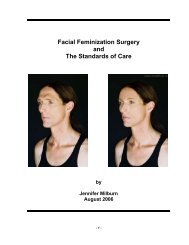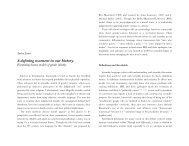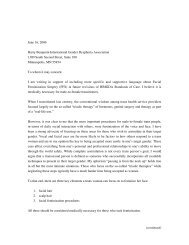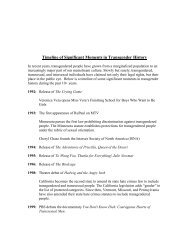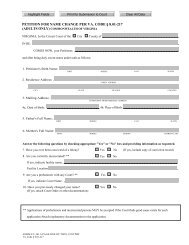Psychophysiological and subjective sexual arousal - Transsexual ...
Psychophysiological and subjective sexual arousal - Transsexual ...
Psychophysiological and subjective sexual arousal - Transsexual ...
- No tags were found...
You also want an ePaper? Increase the reach of your titles
YUMPU automatically turns print PDFs into web optimized ePapers that Google loves.
242 L. A. Brotto et al.number of new women currently in a relationship orcurrently engaging in partnered <strong>sexual</strong> activity.Despite the lower Desire <strong>and</strong> Pleasure scores, thisgroup did not report <strong>sexual</strong> problems overall. Therefore,it appears that this group of MTF individualsexperience satisfactory levels of <strong>subjective</strong> <strong>and</strong>perceived physiological <strong>sexual</strong> <strong>arousal</strong> in their naturalenvironments.With respect to orgasmic function, 40% reportedability to reach orgasm by at least one means, <strong>and</strong>67% reported overall satisfaction with orgasm. Thissuggests that satisfaction with orgasmic function isnot necessarily dependent on the physiological abilityto attain orgasm, at least in this particular group.Given the marked variability of rates of orgasmicability in prior research, <strong>and</strong> the current finding thatsatisfaction is not correlated with ability, one mightconclude that a focus on orgasmic capacity may notbe the optimal endpoint measure of <strong>sexual</strong> functionin this group. Rather, assessment of satisfaction maybe a more accurate measure. Moreover, whichfactors predict orgasmic satisfaction, given that actualorgasmic capacity per se is not a predictor, would bean interesting question to explore.In response to visual <strong>sexual</strong> stimuli presentation,self-reported <strong>sexual</strong> <strong>arousal</strong>, perception of genital<strong>arousal</strong>, <strong>and</strong> perception of autonomic <strong>arousal</strong> increased.This suggests that this particular group ofMTF participants was able to become <strong>subjective</strong>lyaroused in a highly artificial testing situation. Moreover,their positive affect towards the erotic filmincreased, whereas anxiety <strong>and</strong> negative affect wereunaffected. Thus, despite the exclusive hetero<strong>sexual</strong>content of the film, all participants experienced<strong>subjective</strong> pleasure while viewing the film. Thesefindings suggest that future research should continueto explore assessment of <strong>sexual</strong> <strong>arousal</strong> in alaboratory setting using other forms of genital <strong>arousal</strong>assessment.With regards to the main outcome variable in thestudy, we were unable to measure VPA responsesduring the erotic condition due to significant movementartefacts. We present a r<strong>and</strong>om sample of fourVPA outputs in Figure 1; however, the VPAresponses of all 15 participants contained movementartefacts during the erotic segment that rendereddata analysis impossible. In approximately half of thedata outputs we could calculate VPA mean valuesduring the neutral stimulus condition. Thus, thesefindings are not inconsistent with those of Schroder<strong>and</strong> Carroll [16] who detected a VPA signal during aresting baseline condition, but who did not subsequentlypresent their participants with erotic stimuli.Given the dependence on within-subject comparisonsinherent to using the vaginal photoplethysmograph,one cannot make inferences with respectto genital <strong>arousal</strong> during the erotic condition onthe basis of exposure to a baseline condition or toa neutral film alone. We were able to locate onearticle, published in Dutch, which used vaginalphotoplethysmography in a group of MTF women.In their small sample of five individuals, Balsma et al.[32] detected a VPA signal during the erotic filmexposure in only two women, but movementartefacts prevented VPA analysis in the remainingindividuals. The problem of movement artefactstherefore seems characteristic of the study sampleas opposed to the methodological techniques employedat our site alone.A number of explanations might account for thenumerous movement artefacts during the eroticstimulus condition. It is possible that discomfortfrom the inserted probe resulting in movement mightbe responsible. However, when asked about theirlevel of awareness of the probe <strong>and</strong> the amount of painevoked from its insertion, responses were relativelylow (3.9 <strong>and</strong> 1.0, respectively, on a scale from 1 to10). Moreover, awareness of the probe was notrelated to vaginal length. Another explanation forthe numerous artefacts relates to the tissue used toconstruct the neovagina. Balsma <strong>and</strong> colleagues [32]speculated that the movement artefacts may beattributable to muscle contractions because of remainingmale muscle tissue which is stronger in themale pelvic muscles. In natal women the pelvic floormuscles surround the vaginal opening while in MTFwomen the neovagina is created behind the malepelvic floor muscles. Only the levator ani muscles(which are much deeper in the perineum) have asimilar position in both men <strong>and</strong> women. Theseresearchers also suggest that movement artefacts maybe due to the influence of the prostate, which ispreserved in MTF women. In the current study allnew women had undergone penile inversion surgerywhere scrotal tissue is used to line the vaginal vault.Another explanation is that MTF women, as do natalmen, use voluntary pelvic floor contractions as ameans of enhancing vasocongestion.In conclusion, the findings from this studysuggest that the vaginal photoplethysmograph cannotbe considered a viable technique to study theblood flow patterns in the neovagina duringconditions of <strong>sexual</strong> <strong>arousal</strong>. However, the findingthat this group was able to become <strong>subjective</strong>ly<strong>sexual</strong>ly aroused suggests that the laboratoryassessment of <strong>sexual</strong> <strong>arousal</strong> may be acceptable ifalternative forms of objective genital <strong>arousal</strong> measurementare considered. Recently neural activityin response to non-erotic stimuli was measured in agroup of MTF individuals using the P300 wave,<strong>and</strong> was found to significantly differ from a natalcontrol group [33]. It is possible that suchtechniques may be helpful in the psychophysiologicalassessment to <strong>sexual</strong> stimuli in the future. Itmight also be fruitful to re-examine the use ofearlier genital psychophysiological techniques (e.g.,the heated electrode) [22] which, despite theirobtrusiveness, are less susceptible to movementartefacts. With growing sophistication in theassessment of women’s <strong>sexual</strong> <strong>arousal</strong>, we expect



